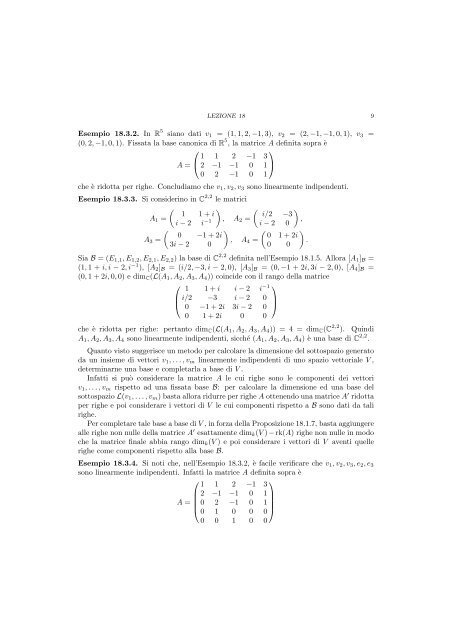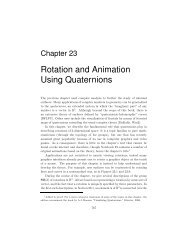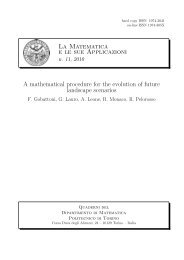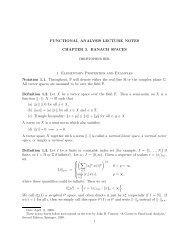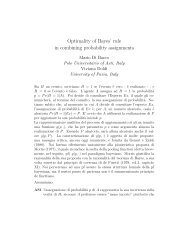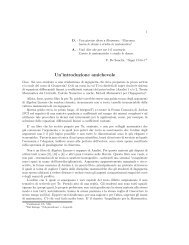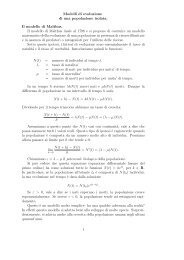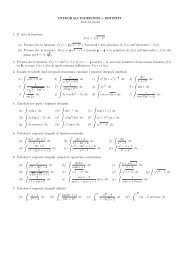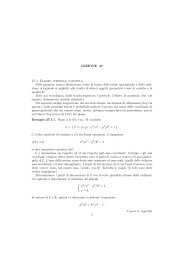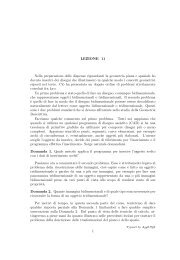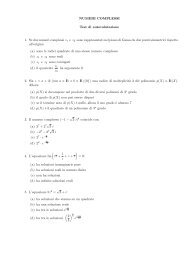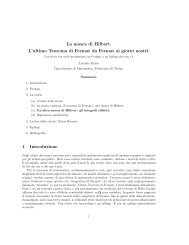Dimensione di uno spazio vettoriale. Dimensione di sottospazi
Dimensione di uno spazio vettoriale. Dimensione di sottospazi
Dimensione di uno spazio vettoriale. Dimensione di sottospazi
Create successful ePaper yourself
Turn your PDF publications into a flip-book with our unique Google optimized e-Paper software.
LEZIONE 18 9<br />
Esempio 18.3.2. In R 5 siano dati v1 = (1, 1, 2, −1, 3), v2 = (2, −1, −1, 0, 1), v3<br />
(0, 2, −1, 0, 1). Fissata la base canonica <strong>di</strong> R<br />
=<br />
5 , la matrice A definita sopra è<br />
⎛<br />
⎞<br />
1 1 2 −1 3<br />
A = ⎝ 2 −1 −1 0 1 ⎠<br />
0 2 −1 0 1<br />
che è ridotta per righe. Conclu<strong>di</strong>amo che v1, v2, v3 sono linearmente in<strong>di</strong>pendenti.<br />
Esempio 18.3.3. Si considerino in C 2,2 le matrici<br />
�<br />
1 1 + i<br />
A1 =<br />
i − 2 i−1 � � �<br />
i/2 −3<br />
, A2 =<br />
,<br />
i − 2 0<br />
� � � �<br />
0 −1 + 2i<br />
0 1 + 2i<br />
A3 =<br />
, A4 =<br />
.<br />
3i − 2 0<br />
0 0<br />
Sia B = (E1,1, E1,2, E2,1, E2,2) la base <strong>di</strong> C 2,2 definita nell’Esempio 18.1.5. Allora [A1]B =<br />
(1, 1 + i, i − 2, i −1 ), [A2]B = (i/2, −3, i − 2, 0), [A3]B = (0, −1 + 2i, 3i − 2, 0), [A4]B =<br />
(0, 1 + 2i, 0, 0) e <strong>di</strong>mC(L(A1, A2, A3, A4)) coincide con il rango della matrice<br />
⎛<br />
1 1 + i i − 2 i<br />
⎜<br />
⎝<br />
−1 ⎞<br />
i/2<br />
0<br />
−3<br />
−1 + 2i<br />
i − 2<br />
3i − 2<br />
0<br />
0<br />
⎟<br />
⎠<br />
0 1 + 2i 0 0<br />
che è ridotta per righe: pertanto <strong>di</strong>mC(L(A1, A2, A3, A4)) = 4 = <strong>di</strong>mC(C 2,2 ). Quin<strong>di</strong><br />
A1, A2, A3, A4 sono linearmente in<strong>di</strong>pendenti, sicché (A1, A2, A3, A4) è una base <strong>di</strong> C 2,2 .<br />
Quanto visto suggerisce un metodo per calcolare la <strong>di</strong>mensione del sotto<strong>spazio</strong> generato<br />
da un insieme <strong>di</strong> vettori v1, . . . , vm linearmente in<strong>di</strong>pendenti <strong>di</strong> <strong>uno</strong> <strong>spazio</strong> <strong>vettoriale</strong> V ,<br />
determinarne una base e completarla a base <strong>di</strong> V .<br />
Infatti si può considerare la matrice A le cui righe sono le componenti dei vettori<br />
v1, . . . , vm rispetto ad una fissata base B: per calcolare la <strong>di</strong>mensione ed una base del<br />
sotto<strong>spazio</strong> L(v1, . . . , vm) basta allora ridurre per righe A ottenendo una matrice A ′ ridotta<br />
per righe e poi considerare i vettori <strong>di</strong> V le cui componenti rispetto a B sono dati da tali<br />
righe.<br />
Per completare tale base a base <strong>di</strong> V , in forza della Proposizione 18.1.7, basta aggiungere<br />
alle righe non nulle della matrice A ′ esattamente <strong>di</strong>mk(V ) − rk(A) righe non nulle in modo<br />
che la matrice finale abbia rango <strong>di</strong>mk(V ) e poi considerare i vettori <strong>di</strong> V aventi quelle<br />
righe come componenti rispetto alla base B.<br />
Esempio 18.3.4. Si noti che, nell’Esempio 18.3.2, è facile verificare che v1, v2, v3, e2, e3<br />
sono linearmente in<strong>di</strong>pendenti. Infatti la matrice A definita sopra è<br />
⎛<br />
1 1 2 −1<br />
⎞<br />
3<br />
⎜ 2<br />
⎜<br />
A = ⎜ 0<br />
⎝<br />
0<br />
−1<br />
2<br />
1<br />
−1<br />
−1<br />
0<br />
0<br />
0<br />
0<br />
1 ⎟<br />
1 ⎟<br />
⎠<br />
0<br />
0 0 1 0 0


